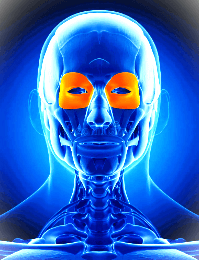Quick Overview
What is Orbicularis Oculi Muscle? The orbicularis oculi is a circular muscle that surrounds the eye. It is responsible for closing the eyelids, blinking, and wrinkling of the skin around the eyes.
The orbicularis oculi muscle is attached to the frontal bone above the eyes, the zygomatic bone at the cheekbones, and the maxilla bone at the upper jaw. It is innervated by the facial nerve and supplied blood by the branches of the facial artery.

Anatomy
The orbicularis oculi is a paired muscle, means that there is one on each side of the face. The two muscles are joined together at the bridge of the nose.
The orbicularis oculi muscle is also attached to the eyelids and the skin around the eyes consisting of both voluntary and involuntary muscle fibers. It is divided into three parts:
- Orbital Part: Surrounds the eye socket.
- Palpebral Part: Encircles the eyelids.
- Lacrimal Part: Near the tear duct.
| Muscle | Description |
| Origin | Medial palpebral ligament, lateral palpebral ligament, lacrimal bone, frontal process of maxilla, zygomatic bone |
| Insertion | Skin of the eyelids |
| Blood Supply | Branches of the facial artery |
| Nerve Supply | Facial nerve |
| Function | Closes the eyelids, blinks, and wrinkles the skin around the eyes |
Table of Contents
Location
The orbicularis oculi muscle is located around the eye. It extends from the inner corner of the eye to the outer corner of the eye and from the forehead down to the cheekbones.
Function
The Orbicularis Oculi muscle performs several crucial functions which are:
1- Blinking: It facilitates the blinking reflex, which protects the eyes from foreign particles and helps distribute tears evenly over the cornea.
2- Eyelid Closure: It plays a central role in closing the eyelids during sleep, intense light, or exposure to potential eye hazards.
3- Expression: The muscle is essential for conveying various emotions, such as joy, sadness, and surprise, through subtle changes in the eyes.
Nerve Supply:
The Orbicularis Oculi muscle is innervated by the facial nerve (cranial nerve VII), which carries the signals required for muscle contraction and eye movement.
Blood Supply:
Blood supply to the Orbicularis Oculi muscle is provided by the branches of the facial artery, ensuring it receives the necessary oxygen and nutrients for optimal function.
Common Orbicularis Oculi Muscle Issues
Some of the common orbicularis oculi muscle issues include:
- Blepharitis: Blepharitis is inflammation of the eyelids. It can cause a variety of symptoms, including redness, swelling, itching, and burning of the eyelids.
- Strabismus: Strabismus, also known as crossed eyes, is a condition in which the eyes do not align properly. This can cause double vision and difficulty focusing.
- Bell’s palsy: Bell’s palsy is a temporary paralysis of the facial nerve. It can cause weakness or paralysis of the muscles on one side of the face, including the orbicularis oculi muscle.
- Crow’s Feet: Over time, repeated contraction of the Orbicularis Oculi muscle can lead to the development of crow’s feet, fine lines at the corners of the eyes. Symptoms like wrinkles at the outer corners of the eyes. Treatment includes Anti-aging skincare products, Botox injections, and facial exercises.
Exercises for Orbicularis Oculi Muscle:
Maintaining the health and strength of the Orbicularis Oculi muscle is essential for preserving youthful and expressive eyes. Here are some simple exercises to incorporate into your daily routine:
1- Eye Yoga:
- Gently close your eyes and roll them clockwise for a few seconds.
- Then, roll your eyes counterclockwise.
- Repeat this exercise several times to relax and strengthen the Orbicularis Oculi muscle.
2- Blinking Exercise:
- Blink your eyes rapidly for 20 seconds.
- Follow with a 10-second break.
- Repeat this exercise to refresh and lubricate your eyes.
3- Facial Massage:
- Using your fingertips, gently massage the areas around your eyes in a circular motion.
- This promotes blood circulation and relaxation of the Orbicularis Oculi muscle.
Questions
1- What is the role of the Orbicularis Oculi muscle in eye health and protection?
This muscle plays a pivotal in maintaining eye health by facilitating blinking, distributing tears, and protecting the eyes from foreign particles and hazards.
2- How can I prevent crow’s feet and fine lines around my eyes associated with the Orbicularis Oculi muscle?
To prevent crow’s feet, consider using anti-aging skincare products, undergoing Botox treatments, and practicing facial exercises to strengthen and tone the Orbicularis Oculi muscle.
3- Are there exercises specifically designed to relax and strengthen this muscle?
Yes, there are exercises like “eye yoga” and gentle eye massages that can help relax and strengthen the Orbicularis Oculi, promoting eye comfort and vitality.
4- Can eye strain and discomfort be attributed to the Orbicularis Oculi muscle?
Yes, prolonged screen time and digital device use can lead to eye strain, which may affect the Orbicularis Oculi. Following the 20-20-20 rule and practicing facial relaxation exercises can help alleviate discomfort.
5- What are some natural ways to maintain the health of the Orbicularis Oculi muscle and keep the eyes expressive?
Maintaining Orbicularis Oculi muscle health can be achieved through regular blinking exercises, eye massages, and adopting a healthy lifestyle, including proper hydration and nutrition to support overall eye health and expressiveness.
